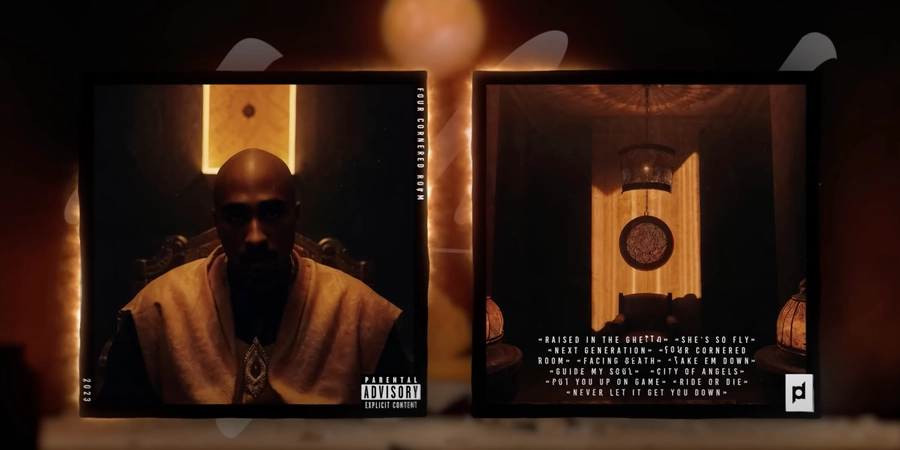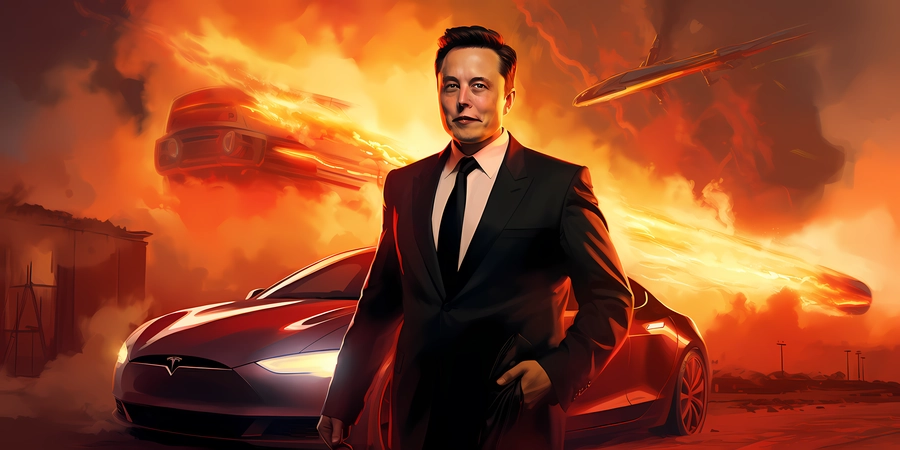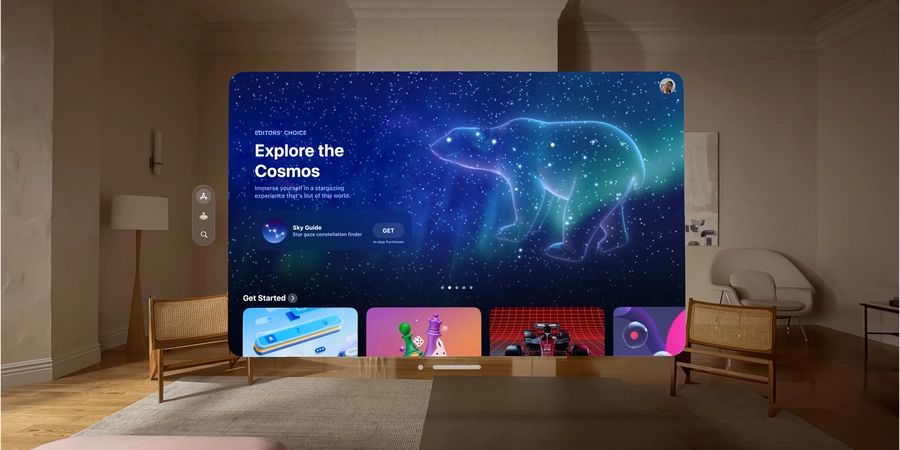# TL;DR
DOPfunk, a visionary music producer, has leveraged AI technology to create “Four Cornered Room 2023,” an album featuring AI-generated vocals of legendary artists 2Pac, Nate Dogg, Aaliyah, and DMX. Through an exclusive interview, DOPfunk shares insights into the creative process, the challenges of authentically replicating the artists’ voices, and the impact of AI on music production. Highlighting the blend of technology and artistry, DOPfunk discusses the significance of preserving these iconic figures’ legacies, the music community’s reception, and the future possibilities AI holds for the industry. This groundbreaking project pays homage to the artists. It opens new avenues for innovation in music, stirring both excitement and ethical considerations about the role of AI in creative fields.
# Introduction
In this compelling interview, we sit down with DOPfunk, a dynamic music producer known for crafting radio-ready rap beats spanning diverse genres. With a flair for blending elements from ’80s disco, ’90s hip-hop, and modern trap soul, DOPfunk has carved a unique niche in the music industry. His YouTube channel showcases an impressive array of beats, instrumentals, and remixes, focusing on genres like G-Funk, West Coast, Hip-Hop, Rap, and Soul. At the same time, his SoundCloud account is a treasure trove of tracks, albums, and playlists for streaming enthusiasts. DOPfunk’s recent venture into AI technology has put him in the spotlight, especially for creating a posthumous collaborative track between the late rappers DMX and 2Pac. The song “Facing Death,” available on DOPfunk’s YouTube channel, has captivated fans worldwide, with many feeling as though the artists have been brought back to life through music. This innovative approach, combined with DOPfunk’s ’90s-influenced sound, makes for a fascinating subject in our interview with Stalin Kay. Join us as Stalin Kay, a visionary in the digital, marketing, and music realms, engages DOPfunk in a deep conversation about the groundbreaking use of AI in music production, his artistic journey, and the impact of his work on the legacy of legendary artists.
# Opening Remarks
Stalin Kay: Thank you for joining us, DOPfunk. We’re excited to dive into the details of your AI-guided 2Pac album.
# Ice Breaker
Stalin Kay: Before we get into the album, I’m curious—do you think 2Pac, also known as Makaveli, is still alive out there somewhere?
DOPfunk: Haha, what a start to set this off! Most certainly not. There has been a time in my life when it was questionable for me, but once you get closer to the emotional and political side of Pac, it is hard to cling to such a belief. He was a revolutionary for many people, and he knew about his impact on so many lives, even on the other side of the planet. I do not think that he would give that up for anything in the world, not even to escape from his certain death.
# Background and Inspiration
Stalin Kay: Reflecting on your belief in 2Pac’s impactful legacy, tell us about your journey in music production. What drew you to the idea of integrating AI technology into your work?
DOPfunk: Because my parents were musicians, I used to listen to many different genres growing up, and it was always the certain “soul” in specific artists that touched me. “Acoustic Alchemy,” “Pain of Salvation,” and “Sade,” for example, made completely different music, but they all had that certain connecting thread that made me FEEL their music. When a friend showed me “Running, Dying to Live” by Pac and Biggie in the early 2000s, I began getting into rap. This was way before fast internet. I grew up without a lot of money, so it took me a few years to expand my horizon and get my hands on everything Pac-related that I could. What finally led me to music production itself was the production of most of the unreleased OG songs by Pac. Instrumentals were rare to come by at that time, and I started rapping with a group of friends, so I learned to produce by reproducing what I liked. After high school, I got my Bachelor’s degree in audio design, worked with a few other artists here in Germany, and tried to grow as an online beat producer until I stumbled onto AI and the crazy possibilities in recent years.
Stalin Kay: That’s quite a journey. What ignited your vision for an album with AI-generated vocals from legends like 2Pac, Nate Dogg, and Aaliyah?
DOPfunk: I’ve started making music by doing what I love and taking inspiration from the artists that inspired me. This is what evolution in music is in its rawest form. So once I got my hands on the tech and began to understand it and to grasp what is possible by simple trial and error, it was only natural for me to try to imitate the artists who gave me so much but were sadly taken from us too early. Imitation itself is an excellent tool for getting a deep feeling of what made someone else special in their artistic expression. Once you’ve got that down to a point, you can use this inspiration to work on your own skills. The album itself wasn’t planned per se. I just released the songs whenever they were done, and people wanted an album to listen to, so I streamlined it, made some adjustments, and it worked.
# Creative Process
Stalin Kay: With your passion for these legendary artists as a foundation, walk us through the creation of the AI-guided 2Pac album. How did you maintain the authenticity of the artists’ styles?
DOPfunk: Listening to Pac for most of my life, I developed a fine-grained understanding of his beat choice, lyricism, cadence, and flow. There is not too much thinking involved in creating these songs; it has to come naturally, and for some of them (“Four Cornered Room,” “Take ’Em Down”), the lyrics just flowed out in about an hour. Of course, there are some words that you will want to use to reflect an artist’s style (Thug, Pain, Hennessy, Souljah, etc.), but other than that, it is just free-flowing thoughts from the pen to the paper. Often, I worked on the beat and the lyrics in parallel, and once I had one verse down, I recorded it, then proceeded to improve the beat and vice versa until I had a complete song. Afterwards, I took my best cuts and sent all tracks separately through RVC to convert my voice to the imitated artist’s voice. From there on, it was just a constant loop of refinement to get the converted voices to sound right (up to 50 work loops and fixes for some of these songs), mixing, and finally mastering the song.
Stalin Kay: That sounds like a meticulous process. Can you discuss the tools and technologies that brought this project to life?
DOPfunk: RVC (Retrieval-Based Voice Conversion) is a free, open-source project to transform voices through trained models. I will not go into detail about how it works exactly, but breaking it down quickly: I have to train a voice model for each artist I want to reproduce. A LOT of time went into isolating vocals, cleaning audio, cutting out double-tracked vocals, and creating datasets that I could then use to train a model. Thankfully, the 2Pac community was always special regarding unreleased songs, master reels, and acapellas, so all that stuff MAY be somewhere out there on the internet. ;) Throughout this process, I learned that even throughout his short career, you could easily discern between Pac’s voice from 1994 and 1996, so I had to train different voice models for different styles. The “hoarse” 1994 model was used on “Guide My Soul,” for example, while I needed a cleaner Death Row 2Pac sound for “She’s Fly” or “Put You Up on Game.” Finally, it is just a matter of preparing your input tracks to be as clean and present as possible and sending them through RVC to transform them.
Stalin Kay: The album lyrics are well-researched and mention the Black Panthers. How important was it to include such historical references?
DOPfunk: As I said before, the aspect of Pac that always stuck with me the most is his political and interpersonal passion. To this day, he gives people faith and power to hold on and handle whatever they are going through. A lot of his charisma and determination to infect other people with this strength was given to him by his mother and his upbringing. His speech at the Indiana Black Expo in 1993 is an absolute must-watch for everyone who hasn’t seen it before. The Panthers, much like him, were trying to fight for a better world but had to face repercussions and realized that you cannot always turn the other cheek. In the worst case, you have to become militant and fiercely fight for what is right. And I think this same mentality is why Pac resonates with people worldwide to this day because he was one of the rare people who showed us that you can be humble and peaceful, but if people see that as a weakness and prey on you, it is invaluable to defend yourself with a fury.
# Artistic Insights
Stalin Kay: The authenticity of The Game’s verse on “Put You on Game” and Dr. Dre’s verse has been highly praised. How did you achieve this?
DOPfunk: Actually, a lot of people have told me that the Dr. Dre verse is too complex and lyrical for Dre, but I disagree with them. Dre is known for his slow, thick flows, but many people need to remember his faster songs. He is a versatile artist, often only limited by having to stick to an image and his perfectionism. So, I tried to take inspiration from his early days and the 2000s, when he dominated the industry. As for The Game, I can’t talk too much about him as I was never really into his music, to be quite honest. When creating a dataset for an artist, I have to listen to their whole discography to filter out what is usable. I often unconsciously pick up on styles and characteristics that I use in my writing process.
Stalin Kay: Your verse on “Raised in the Ghetto” has intrigued many. Can you share the inspiration behind it?
DOPfunk: I’m not sure what you mean with my verse. Are you referring to the first one? That is Scarface, actually. I could not exclude him from this album. I think he is one of the most prolific songwriters and storytellers ever to touch a microphone, and sadly, he and Pac never really did songs together except for “Smile.” I hope I did him justice. But now that I think about it - it really is my verse. The story I told in that verse hits close to home and is based on my childhood - being a dreamer.
# Musical Exploration
Stalin Kay: Why didn’t the album explore instrumentals with modern hip-hop/rap sub-genres like trip-hop, similar to beats on albums by artists like ¥$, Kanye West, Ty Dolla $ ign’s album, Vultures 1, which is Billboard number 1 and popular across streaming platforms in many countries?
DOPfunk: Honestly, I do not like modern rap, and I don’t even KNOW half of these cats. There are a few artists here and there that still do great music, but the whole industry has degenerated into a mess that I can barely recognize as rap or hip-hop. To each his own, but I cannot create art that doesn’t fulfil me or give me a sense of creating worth. Emotional, passionate worth, that is.
# Collaboration Choices
Stalin Kay: The album doesn’t feature usual 2Pac collaborators like E-40, Richie Rich, Rappin’ 4-Tay, Kurupt, George Clinton, Roger Troutman, and Outlawz. A Notorious B.I.G feature would have been interesting, too, especially from a Life After Death perspective. What influenced these collaboration choices?
DOPfunk: It is just too much for one person to handle! I have to get into character and feel the artists I am imitating, so of course, I went with the ones I know best from listening to them daily. Then there are the legal issues, of course. I don’t know how rappers who are still active today and do their own thing (just like they did in their prime) would react, and I honestly don’t want to take the food off their plates. BUT: I am working on my next project, with one Biggie feature already released, and there may be some people featured that collaborated with Pac and that I have not imitated yet ;)
# Professional Endeavors
Stalin Kay: Are you involved with BeatStars, and as a music producer, how can artists land a beat or instrumental from you?
DOPfunk: Absolutely! BeatStars is a great platform to sell and purchase beats, and I also offer services like mixing and custom hooks on there. At the moment, that is all I can offer for artists who want to work together, as dedicated projects with people are too time-consuming. But I hope to get back into working with talented artists again in the future.
# Accessibility and Impact
Stalin Kay: How accessible is the AI-guided technology used in creating the album, and how can it benefit the upcoming and the next generation of artists across different genres?
DOPfunk: The tech that I am using right now is not as easily accessible as most people would like it to be. It involves a lot of trial and error. It depends on underlying systems such as Python and dependencies that cannot be installed like a simple app or program. There are alternatives like “Rubin AI Replay”, which streamline the usage and make it more accessible, but they are limited in their feature set as well. And of course, there are online services, but all of them are based on the initial RVC open-source project, and in my opinion, it goes against the very essence of open source to commercialize the work of someone else, so you won’t be seeing me break a lance for them.
Stalin Kay: How has the AI technology used in this album changed your financial and social life?
DOPfunk: It certainly allowed me to invest in new and better equipment to develop further and improve my craft. YouTube does not pay life-changing sums for me right now, so I ensure that everything I earn is further invested in improving the art. Mind you, I recorded the first songs with a cheap $30 podcast mic in my untreated living room. Now, I’ve got a pretty solid setup to optimize my whole workflow. Socially, a lot has stayed the same. My friends and family know what I am doing and often ask about the technicalities of my work. It is great to talk about it to realize further the steps and improvements that I made without really grasping them.
# Future Vision
Stalin Kay: Some have commented that the album deserves a Grammy award. How do you feel about such high praise, and what do you think it says about the future of AI in music?
DOPfunk: I am absolutely blown away and honored by the reactions I get for my work. Of course, I don’t know what to think about the whole Grammy situation because I never really paid attention to any awards. Great music can be a shiny statue or status for you to enjoy it. While it would look good on my resume, the feedback I get from listeners themselves keeps me going. People sharing their personal stories, tragedies, and connecting through music is the very essence of the art.
Stalin Kay: With the emergence of technologies like the Metaverse, Spatial Computing, Apple Vision Pro, or Meta Quest 3, how do you feel about bringing deceased artists back to life in these new digital realms?
DOPfunk: We have to remember that all this technology is just a crutch to create a hollow image of the people we lost. There is no way to capture the very essence of a human being. It is similar to looking at a picture of a passed love or friend — it will not bring the person back. It will only liven up the memories that you had with them. I am strongly against the big industry trying to further profit from dead artists, and that’s the brilliant part of the current technology. Everyone can get their hands on it and use it as a tool to create. Once it is used in a straight commercial sense to capitalize further and feed an industry that has been doing its best to DESTROY art and creativity for the last 20 years, we are doomed to become mindless consumers once again.
Stalin Kay: The project raises complex copyright implications for AI-guided works. How could entrepreneurial artists leverage this approach while navigating these legal waters?
DOPfunk: The whole thing is a grey area right now, and you can bet that future signed artists will have clauses in their contracts giving exclusive rights to their likeness and voice to the big players in the industry. I don’t know where this is leading, and I might get sued into oblivion in the coming years, but artists in every aspect always had to take risks and navigate moral dilemmas. Just like other AI technologies, this should stay in the hands of the people, and governments around the world should keep restrictions to a minimum, if at all. I personally think it is my moral obligation to make sure to always flag my work as “AI Guided” and make it crystal clear that the original artists had no association with the project. That is all we can do for now.
Stalin Kay: What was the most challenging aspect of working on this project, and how did you overcome it?
DOPfunk: The fear of legal repercussions held me back a bit when the first songs began to reach a broad audience. I am just one dude in his living room, recording music, and suddenly, I might have to face a billion-dollar industry that is hellbent on extracting the last dime from their “products.” After many days of contemplating, I realized I don’t care about the negative impact. Or to say it in Pac’s words: “I don’t give a f***.” I’ve been following rules, navigating the industry, and trying to find my way without treading on anybody’s toes for years, and I was tired of it.
Stalin Kay: Among the tracks on the album, do you have a favorite song? If so, which one, and why does it stand out to you?
DOPfunk: “Four Cornered Room” certainly made the biggest impact and catapulted the whole thing onto many people’s radar. There is this guy called “Flix Talk” on YouTube who did a live reaction, and its impact on him really moved me, so that was one of my favourite moments that kept me motivated. But personally, my favourite is “City of Angels”, as it felt right to pay tribute to many of the people who moved us and passed away too early.
Stalin Kay: Do you plan to collaborate with Death Row Records or the Tupac Amaru Shakur Foundation on an official AI-guided posthumous 2Pac album?
DOPfunk: Pac’s legacy went through so many hands, and his music has been mishandled on many posthumous albums. Many masters are sitting in Daz’s vault, I think, and there is no “one” authority to contact or trust with his legacy. I am currently navigating the maze of deciding who to trust and who to contact. Would I want to contact the old Death Row people if they were involved in Pac’s death? Questions, man, questions. I reached out to Snoop, so I may be on his radar.
Stalin Kay: With the recent breakthrough in 2Pac’s murder case, how do you feel about the developments, and do they influence your work in any way?
DOPfunk: Most definitely. The whole Keefe D story blew over and inspired me to write “Take ’Em Down.” I think that we will NEVER get a satisfying conclusion to Pac’s death, and I certainly don’t know how far government agencies were involved because of his political impact. We can all piece together our beliefs by the theories we deem plausible, but we will never truly know the truth.
Stalin Kay: What are your general thoughts on AI in music and its impact on the industry?
DOPfunk: At the moment, AI is an excellent tool for productivity, and it will probably revolutionize the industry as we know it. Who needs the 50th yearly hit banger by some puppet singer who is interchangeable and often produced by the same people in the background when AI can do it just as well? Who creates the ART in the industry right now? Do we need Dua Lipa if there is an AI that can generate a PERSONAL song in seconds with a video and make that woman look twice as good? Real artistry and music will further leave the digital realm and happen in reality - the masses will accept their regurgitated charts just like before.
Stalin Kay: Speaking of future projects, do you plan to create more AI-guided albums, and if so, can you give us a hint of what’s next?
DOPfunk: I am indeed working on something with a wider variety of artists, but I am not ready to disclose any information at the moment. If you liked the first project, you will love this one!
Stalin Kay: For fans eager to support and purchase the “Four Cornered Room 2023” album, where can they find it?
DOPfunk: Right now, it can only be downloaded from Bandcamp for a small donation. If people want to support me, listen to the originals on Spotify or Apple Music or play the stuff on YouTube!
Stalin Kay: Lastly, what do you believe is the significance of using AI in music production, especially when it comes to preserving the legacies of artists who have passed away?
DOPfunk: I think AI will help artists broaden their spectrum to create unimaginable things. We just started, and the industry is already visibly shaken. A lot of people who feel wronged by mechanisms that kept them down from regurgitating what is popular will see this opportunity to move in ways that the industry itself cannot because it is too slow to adapt and too stubborn to change. Preserving the legacies and continuing them is now in the hands of the people and not in the control of a few decision-makers anymore. And the mistreatment of 2Pac’s legacy is the best example of why this is a good thing.
# Closing Thoughts
Stalin Kay: Thank you, DOPfunk, for sharing your insights and experiences with us. Your innovative approach to music production is genuinely inspiring, and we wish you the best in your future endeavours. The album is a well-researched homage to the West Coast sound and 2Pac’s era, reflecting a deep understanding of the genre and its cultural significance.
Note: This interview was crafted with the assistance of Perplexity AI, an advanced tool designed to support content generation and provide insights for creative and analytical tasks.
About Perplexity AI: Perplexity AI is a state-of-the-art AI tool that assists with content generation and provides insights, supporting professionals in journalism, research, and content creation to produce high-quality, informed content efficiently.
About Stalin Kay: Stalin Kay is a visionary entrepreneur who has been at the forefront of the digital landscape for over 15 years. With a passion for marketing, music, and technology, he has been a driving force in helping businesses grow and thrive online. His Twitter/X handle, @stalinkay, is a hub for sharing marketing, music, and technology insights as he continues to inspire and empower his audience.
# Revolutionizing Hip-Hop: “Four Cornered Room” - The AI-Generated 2Pac Album with Authentic Vibes
’‘Take’em Down’’ is track number 7! Classic Makaveli move! Listening to this album felt like listening to my first 2Pac album decades ago. Thank you for taking me back and touching my heart. This is a true love letter to Pac’s music and heritage.
Album is straight 🔥. Pac’s spirit lives on thru this album. Been listening to Pac since I was in third grade. Made my whole year hearing this. RIP to the GOAT. Makaveli lives on. Favorite track: Never Let It Get You Down.
This touch my heart deeply. Thank you so much 👊🏽💯 Favorite track: Never Let It Get You Down.
The album “Four Cornered Room” is a posthumous release featuring the iconic rapper 2Pac, created using artificial intelligence (AI) voice conversion technology. Released on December 26, 2023, this innovative project has sparked mixed emotions and discussions within the rap community. The AI technology employed on the album has replicated 2Pac’s distinctive flow and voice, leading to a collection of tracks that many listeners have found impressive. In contrast, others have raised concerns about the ethical implications of using AI to simulate an artist’s voice posthumously.
The album includes tracks such as “Raised In The Ghetto,” which incorporates lines from 2Pac’s own poetry, specifically from “The Rose That Grew From Da Concrete,” suggesting an effort to maintain authenticity and respect for 2Pac’s legacy as a poet. Despite the controversy, some fans have embraced the album, praising its quality and the technology’s ability to match beats per minute (BPM) more accurately than human remixing, resulting in a seamless listening experience.
The album has been made available on various platforms, including SoundCloud, where it can be streamed. It was produced and written by an artist known as DOPfunk, who has been recognized for his talent in creating lyrics and utilizing AI to sample the voices of iconic artists like 2Pac and DMX.
If you are interested in exploring this blend of hip-hop and cutting-edge technology, “Four Cornered Room” can be found and listened to through the following link:
# Further Reading Resources**
Dive deeper into the fusion of AI and music with these selected resources, where you’ll find a wealth of information on how AI technology is being used to recreate the music of legends like 2Pac, Nate Dogg, Aaliyah, and DMX by DOPfunk and others. These resources cover the technological advancements, applications, and the ongoing ethical debate surrounding AI in the realm of music production:
-
Dexerto Article on AI-Generated Song by DOPfunk: A compelling look into how YouTuber DOPfunk employed AI to craft a posthumous duet featuring DMX and 2Pac, sparking widespread discussions on the impact of AI in the music industry.
-
Speechify Blog on Text to Speech 2Pac: This article dives into the development of text-to-speech technology and its remarkable ability to emulate 2Pac’s voice, highlighting the vast potential applications beyond entertainment.
-
Toolify AI News on Tupac’s Legacy and AI-Generated Tracks: An insightful examination of Tupac’s lasting influence on music and culture, along with the controversies and promise of AI-generated tracks in both preserving and expanding upon his legacy.
-
YouTube and SoundCloud for AI Voice Conversion Tracks: Experience the innovative capabilities of AI voice conversion technology firsthand through various AI-generated tracks available on YouTube and SoundCloud:
- Discussion Forums and Social Media on AI in Music: Participate in the conversation on platforms like Reddit and Section Eighty, where enthusiasts and skeptics alike debate the ethical considerations of utilizing AI to recreate the voices of deceased artists and share discoveries of new AI-generated tracks:
These selected resources offer a nuanced view of AI’s role in music production, showcasing the technology’s potential to innovate while also engaging with critical ethical considerations about the future of music creation with the voices of iconic figures like 2Pac and others.






